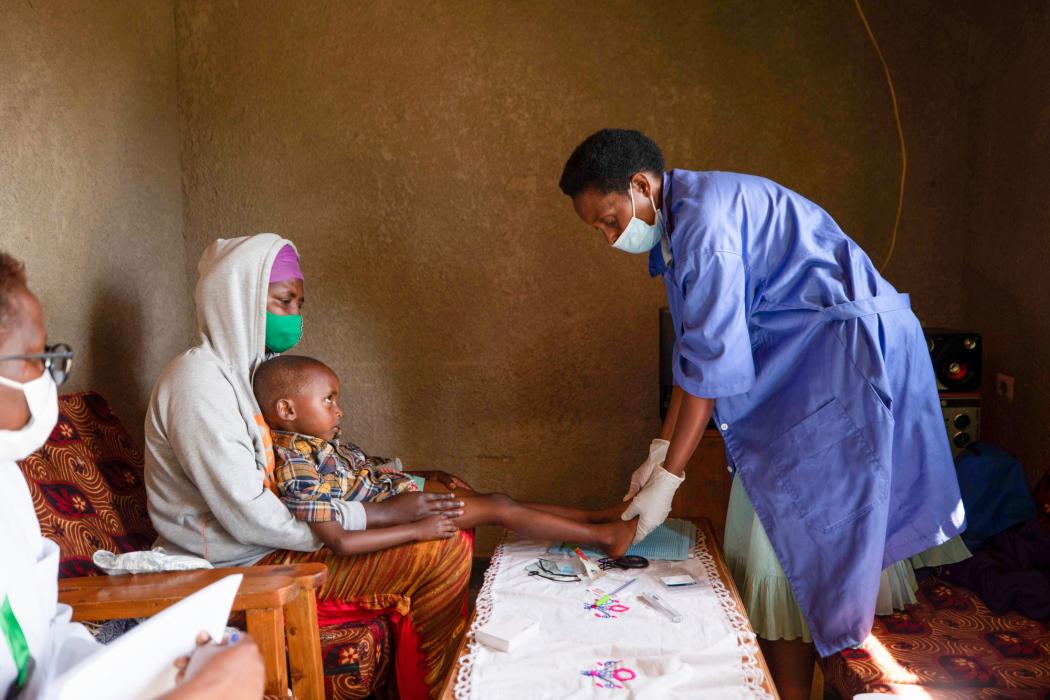The Future of Global Health Starts with Health Workers

Ruth Uwibohoye, a health worker, cares for a child at Nyanza Hospital in Nyanza District, Rwanda. Ruth is supported by the IntraHealth International-led and USAID-funded Ingobyi project to reduce preventable infant and maternal deaths, reduce the incidence of malaria, and bring high-quality, integrated health services to more Rwandan mothers, children, and adolescents. Photo by Innocent Ishimwe for IntraHealth.
In the global health community, we often focus on results and big numbers. How many people have we reached? How many screenings, tests, treatments? At times, we tend to forget that behind every result, every success, are human beings: health workers and the people they care for.
When you’re sick, what you want is a health professional to take care of you, to approach your care as a human being, not as someone who is only interested in your disease.
Health workers are the backbone of any health system, and they will be at the core of progress in global health.
Adopting a people-centered approach is critical in the context of the evolving burden of disease. Historically, infectious disease required a single interaction between the health system and the patient; with chronic diseases there must be multiple interactions between the client and the health system, over long periods of time. More than ever, the relationship between the client and the health worker ought to be based on mutual trust.
As such, health workers are the backbone of any health system, and they will be at the core of progress in global health. They are the first point of contact for clients, providing care and support when people need it most. Yet, despite their critical role, health workers are too often undervalued, underpaid, and overworked within incredibly difficult conditions.
I fully support the Frontline Health Workers Coalition theme of “Invest in Health Workers” for World Health Worker Week. The World Health Organization estimates that there will be a shortage of 10 million health workers by 2030. Urgent action is needed to address this situation. Donors must move beyond vertical disease funding to allocate funding for long-term health systems and health workforce strengthening.
Donors must move beyond vertical disease funding to allocate funding for long-term health workforce strengthening.
In my view, there are five fundamental steps countries and their partners in the global health community should take to bring health workers back to the center of health systems:
- Supply health workers with the resources they need to provide high-quality care. This includes funding for personnel, equipment, and supplies. It also includes funding for research and innovation to improve health outcomes and strengthen health systems.
- Provide new health workers with adequate training to handle the increasing complexity of comorbidities that affect their clients. Practicing health workers need ongoing training to keep them up to date with evolving guidelines. This requires that countries invest in education and training programs, as well as providing health workers with opportunities for career advancement and professional development.
- Establish safe, decent working conditions for health workers. This includes protection from violence and harassment, adapted biosafety protocols and supplies, and access to decent living conditions with basic commodities, such as water and electricity. It also includes incentives for health workers to stay in their communities and work in underserved areas.
- Integrate community health workers into national health systems and pay them fairly. Community health workers are often the only point of contact for people living in remote or underserved areas. By integrating community health workers into national health systems, countries can help ensure that everyone has access to the care and services they need.
- Involve frontline health workers—including women, nurses, midwives, and community health workers—in health policymaking. This is the only way to develop health policies that are informed by the needs and experiences of health workers. This includes providing opportunities for health workers to participate in policy development and implementation, as well as ensuring that health workers have access to the resources they need to provide high-quality care.
Health workers are the true heroes of the health systems, yet too often they are invisible. Without adequate investment in health workers, no country will be able to achieve universal health coverage by 2030.
In the COVID-19 era, voices are rising from low- and middle-income countries, asking donors to invest in resilient health systems, rather than in vertical funding.
Let’s trust and support countries that invest in strengthening health systems and up-skilling health workers. Because a resilient and agile health system is one that can adapt to the evolving needs of chronic diseases and future pandemics, and one that can save lives. By investing in health workers, we can help ensure that everyone has access to the care and services they need, regardless of where they live.
